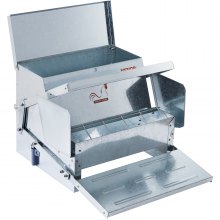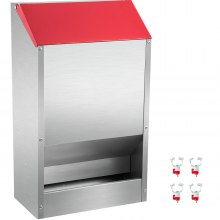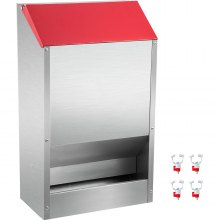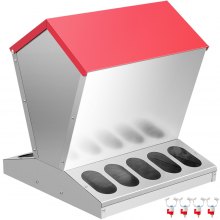Chicken Feeders From Hand-Scattered Grains to Automated Feeders With VEVOR
Over the centuries, poultry feeding relied heavily on artisanal and traditional methods. Farmers relied on the natural feeding habits of chickens to painstakingly scatter grain on chicken floors to identify and eat their feed. Still, chicken feed has changed dramatically in the 21st century, with rapid advances in digital technology and mechanical engineering.
Companies like VEVOR have emerged as pioneers in this field, harnessing the power of robotics, sensors, and data analytics to create state-of-the-art automated feeders. These modern marvels are equipped with programmable feeding schedules, portion control, and remote monitoring capabilities, empowering farmers to optimize feeding regimes with unparalleled precision and efficiency.
Different Materials Of Chicken Feeders
Chicken feeders are made with various materials. From the days of the traditional feeders till date, when automated chicken feeders are most popular, most of these materials have already been used. Manufacturers continually develop them because they have different features and benefits.
Plastic
Plastic is a popular material for poultry feed because of its light weight, durability, affordability, and corrosion resistance. Plastic feeders are easily cleaned and washed, making them ideal for maintaining hygiene in poultry areas. They also come in various colors and designs, allowing farmers to choose products that best suit their tastes and group needs.
Galvanized Steel
Galvanized steel feeders are known for strength and durability. They are resistant to rust and corrosion, making them suitable for outdoor use in severe weather conditions. While they may be heavier than plastic feeders, they offer excellent longevity and do not require frequent replacement, making them a worthwhile long-term investment.
Wood
Wooden feeders offer a rustic appearance. They are often handmade or custom-made and can be made to specific sizes and shapes; some are adapted to the needs of the livestock. Wood feeders are relatively easy to make and repair, making them popular with DIY enthusiasts. However, wood is susceptible to water and insect damage compared to other materials, so it requires regular maintenance and treatment to ensure longevity.
Essential Accessories For Chicken Feeder
Chicken feeders function better with some accessories. These accessories improve the feeding condition, help maintain an efficient feeding procedure, and prevent contamination.
Adjustable Height Extensions
Height-adjustable rows allow farmers to increase or decrease feed rates to suit the size and age of the chickens. For example, keeping the chicks in a low range can nurture them as they grow and make it easier to find food. Adjustable height extensions offer flexibility and versatility, allowing farmers to adapt to changing needs and preferences.
Feed Level Indicators
Feed quantity indicators provide a visual indicator or measure of the amount of feed remaining on the menu. They help farmers monitor feed intake and replenish feed as needed, prevent feed shortages, and ensure continuous feed supply to sheep. Feed level indicators can be simple markers or more sophisticated electronic sensors, depending on the design of the feeder.
How To Maintain Your Automated Chicken Feeders For Optimal Performance
Automated feeders are considerable financial investments. With their high prices, you should get the best possible from your purchase. Therefore, we have put together tips for making your automated chicken feeders work optimally and last long.
Regular Cleaning
Regular cleaning is essential to prevent the accumulation of dirt, food debris, and bacteria that can affect feeder performance and cleanliness. clean the feeder at least once a week or as needed, based on the manufacturer’s recommendations and frequency.
Thoroughly clean all feeder parts with a mild detergent or disinfectant and warm water, including the hopper, feeding tray, dispensing mechanism, and sensors. Rinse with fresh water and dry the feeder completely before replenishing it with food.
Inspect for Damage
Check the feeder periodically for any signal damage, deterioration, or malfunction. Look for cracks, loose screws or screws, worn parts, or other issues that could compromise feeder integrity or operation.
Replace damaged components immediately to prevent further damage and ensure proper operation. Pay attention to moving parts such as motors, gears, and sensors, and lubricate them to prevent friction and damage.
Adjust Settings
Monitor and adjust feeder programs as necessary to meet the changing needs of the sheep. Adjust the feeding schedule, portion sizes, or allotment times based on chicken age, size, breeding, and growth stage.
Consider seasonal changes in food intake and adjust schedules accordingly to avoid overeating or binge eating. Familiarize yourself with the feeder's programming interface or control panel to make specific adjustments and ensure optimal feeding management.
Why Choose VEVOR Chicken Feeder?
VEVOR offers a range of poultry feeds to suit different groups, breeds, and farming practices. Whether for backyard hobbyists, small growers, or commercial applications, VEVOR feeders come in various sizes, capacities, and configurations to suit various needs and preferences.
VEVOR poultry feeders are designed to improve feed efficiency and reduce feed waste, helping farmers use inputs more efficiently and reduce operating costs. In addition, VEVOR prioritizes design and user-friendliness, making it easier to install, operate, and maintain its poultry feeders. Simple communication, clear instructions, and implementing a simple feeding process reduce farmers' learning curves.
Besides the chicken feeder, VEVOR has several other items for your farming and livestock needs, making us your one-stop shop for livestock supplies. With this, your shopping is streamlined and easier. You also do not have to pay separate delivery fees when you can get everything from us and ship flatly.
FAQs About Chicken Feeders
There are different types of baby feeders, such as gravity feeders, treadle feeders, automatic feeders, pan feeders, tube feeders, and tripod/suspension feeders, and each type has its benefits and suitability for different groups, environments, and maintenance.
Can I use the same feeder for chicks and adult chickens?
While some feeders are suitable for adult chickens and poultry, it is important to consider the feeder design, height, and feeding method to ensure accessibility and safety for all birds. Adjustable height extensions or removable partitions allow you to tailor the feeding to the different age groups can be done. Again, choose feeders with the right size and feeding habits for the birds.
How do I troubleshoot common issues with chicken feeders?
The most common issues with poultry feeders are feeding stuffing, blockage, jamming, sensor faults, or dispenser faults. Refer to the manufacturer's instructions or troubleshooting guide for specific troubleshooting suggestions. Check for feeder obstructions, change settings, clean or replace worn parts, and perform regular maintenance to ensure proper operation.

























































































































































































